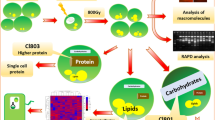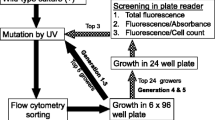Abstract
In this study, a high lipid-accumulating mutant strain of the microalgae Scenedesmus dimorphus was developed via radiation breeding. To induce mutant strain, S. dimorphus was gamma-irradiated at doses from 100 to 800 Gy, and then a mutant (Sd-Pm210) with 25 % increased lipid content was selected using Nile red staining methodology. Sd-Pm210 showed morphological changes and had higher growth rate compared to the wild type. From random amplified polymorphic DNA analysis, partial genetic modifications were also observed in Sd-Pm210. In comparisons of lipid content between wild type and Sd-Pm210 using thin-layer chromatography, the content of triacylglycerol was markedly higher in the Sd-Pm210 strain. The total peak area of fatty acid methyl ester was shown to have about 1.4-fold increase in Sd-Pm210, and major fatty acids were identified as palmitic acid, oleic acid, linoleic acid, and linolenic acid. To define the metabolic changes in the mutant strain, 2-dimensional electrophoresis was conducted. Several proteins related to lipid synthesis and energy metabolisms were overexpressed in the mutant strain. These results showed that radiation breeding can be utilized for the development of efficient microalgae strains for biofuel production.





Similar content being viewed by others
References
Al-Zahim MA, Ford-Lloyd BV, Newbury HJ (1999) Detection of somaclonal variation in garlic (Allium sativum L.) using RAPD and cytological analysis. Plant Cell Rep 18:473–477
Baillie BK, Belda-Baillie CA, Silvestre V, Sison M, Gomez AV, Gomez ED, Monje V (2000) Genetic variation in Symbiodinium isolates from giant clams based on random-amplified-polymorphic DNA (RAPD) patterns. Mar Biol 136:829–836
Berberoglu H, Gomez PS, Pilon L (2009) Radiation characteristics of Botryococcusbraunii, Chlorococcumlittorale, and Chlorella sp. used for CO2 fixation and biofuel production. J Quant Spectrosc Radiat Transf 110:1879–1893
Bligh EG, Dyer WJ (1959) A rapid method of total lipid extraction and purification. Biochem Physiol 37(8):911–917
Brennan L, Owende P (2010) Biofuels from microalgae—a review of technologies for production, processing, and extractions of biofuels and co-products. Renew Sustain Energy Rev 14:557–577
Browse J, McCourt PJ, Somerville CR (1986) Fatty acid composition of leaf lipids determined after combined digestion and fatty acid methyl ester formation from fresh tissue. Anal Biochem 152:141–145
Brune DE, Lundquist TJ, Benemann JR (2009) Microalgal biomass for greenhouse gas reductions: potential for replacement of fossil fuels and animal feeds. Environ Eng 135:1136–1144
Chen W, Zhang C, Song L, Sommerfeld M, Hu Q (2009) A high throughput Nile red method for quantitative measurement of neutral lipids in microalgae. Microbiol Methods 77:41–47
Choi YE, Hwang H, Kim HS, Ahn JW, Jeong WJ, Yang JW (2013) Comparative proteomics using lipid over-producing or less-producing mutants unravels lipid metabolisms in Chlamydomonads reinhardtii. Bioresour Technol 145:108–115
Day JG, Benson EE, Fleck RA (1999) In vitro culture and conservation of microalgae: applications for aquaculture, biotechnology and environmental research. In Vitro Cell Dev Biol Plant 35:127–136
de Morais MG, da Cruz Reichert C, Dalcanton F, Durante AJ, Marins LF, Costa JAV (2008) Isolation and characterization of a new Arthrospira strain. Z Naturforsch 63(11):144–150
Deng X, Li Y, Fei X (2009) Microalgae: a promising feedstock for biodiesel. Microbiol Res 3:1008–1014
Dismukes GC, Carrieri D, Bennette N, Ananyev GM, Posewitz MC (2008) Aquatic phototrophs: efficient alternatives to land-based crops for biofuels. Curr Opin Biotechnol 19:235–240
Duffy JE, Canuel EA, Adey W, Swaddle JP (2009) Biofuels: algae. Science 326:1345
Gouveia L, Oliveira AC (2009) Microalgae as a raw material for biofuels production. Ind Microbiol Biotechnol 36:269–274
Griffiths MJ, Harrison STL (2009) Lipid productivity as a key characteristic for choosing algal species for biodiesel production. Appl Phycol 21:493–507
Shah GC, Yadav M, Tiwari A (2012) Assessment for the higher production of biodiesel from Scenedesmus dimorphus algal species. Erud J of Biotechnol 1:1–9
Hu Q, Sommerfeld M, Jarvis E, Ghirardi M, Posewitz M, Seibert M, Darzins A (2008) Microalgal triacylglycerols as feedstocks for biofuel production: perspectives and advances. Plant 54:621–639
Kosaric N, Velikonja J (1995) Liquid and gaseous fuels from biotechnology: challenge and opportunities. Microbiol Rev 16:111–142
Lepage G, Roy CC (1984) Improved recovery of fatty acid through direct transesterification without prior extraction or purification. Lipid Res 25:1391–1396
Li Y, Han D, Hu G, Dauvillee D, Sommerfeld M, Ball S, Hu Q (2010) Chlamydomonas starchless mutant defective in ADP-glucose pyrophosphorylase hyper-accumulates triacylglycerol. Metab Eng 12:387–391
Llman AM, Scragg AH, Shales SW (2000) Increase in Chlorella strains calorific values when grown in low nitrogen medium. Enzyme Microbial Technol 27:631–635
McGinnis KM, Dempster TA, Sommerfeld MR (1997) Characterization of the growth and lipid content of the diatom Chaetoceros muelleri. Appl Phycol 9:19–24
Scurlock JMO, Hall DO, House JI, Howes R (1993) Utilizing biomass crops as an energy source: a European perspective. Water Air Soil Pollut 70:499–518
Suda Y, Yoshikawa T, Okuda Y, Tsunemoto M, Tanaka S, Ikeda K, Miyasaka H, Watanabe M, Sasaki K, Harada K, Bamba T, Hirata K (2009) Isolation and characterization of a novel antistress gene from Chlamydomonas sp. W80. J Biosci Bioeng 107:352–354
Vigeolas H, Duby F, Kaymak E, Niessen G, Motte P, Franck F, Remacle C (2012) Isolation and partial characterization of mutants with elevated lipid content in Chlorella sorokiniana and Scenedesmu sobliquus. Biotechnology 162:3–12
Yoon MC, Choi JI, Kim GH, Kim DH, Park DH (2013) Proteomic analysis of Spirogyra varians mutant with high starch content and growth rate induced by gamma irradiation. Bioprocess Biosyst Eng 36(6):757–763
Yoon MC, Yang HY, Lee SS, Kim DH, Kim GH, Choi JI (2013) Characterization of gamma radiation inducible thioredoxin h from Spirogyra varians. Enzyme Microbial Technol 53(3):136–142
Acknowledgments
This research was supported by Golden Seed Project, Ministry of Agriculture, Food and Rural Affairs(MAFRA), Ministry of Oceans and Fisheries(MOF), Rural Development Administration(RDA), and Korea Forest Service(KFS), by the research supporting program by Chonnam National University 2013, and by the Antarctic organisms: Cold-Adaptation Mechanisms and its application grant (PE14070) funded by the Korea Polar Research Institute.
Author information
Authors and Affiliations
Corresponding author
Rights and permissions
About this article
Cite this article
Choi, Ji., Yoon, M., Joe, M. et al. Development of microalga Scenedesmus dimorphus mutant with higher lipid content by radiation breeding. Bioprocess Biosyst Eng 37, 2437–2444 (2014). https://doi.org/10.1007/s00449-014-1220-7
Received:
Accepted:
Published:
Issue Date:
DOI: https://doi.org/10.1007/s00449-014-1220-7




